The Copa América third-place playoff was contested between one of the pre-tournament favourites, Uruguay, and the over-performing Canada.
Uruguay were evidently recovering from their heartbreaking loss to Colombia, where their dreams of winning the competition were shattered.
Meanwhile, Canada came into the game in high spirits, knowing they had exceeded expectations to have reached the semi-finals, providing much hope for their highly anticipated appearance in the 2026 World Cup.
However, in a match that Canada dominated, it was Uruguay who came out victorious.
Having been able to create very little throughout the game, the talismanic figure of Luis Suárez took the game to penalties by scoring a late equaliser.
Uruguay held their nerve and secured third sport with a win in the penalty shootout.
Ismaël Koné disappointingly missed a penalty during the shootout, which gave Uruguay a vital advantage.
However, Koné put in an outstanding performance, that will have certainly caught the eye of many.
The 22-year-old scored an audacious bicycle kick, which was an integral part of the second goal.
Kone’s performances this season have earned him a move to Ligue 1 giants Marseille, who will have been pleased to see Kone thriving against such strong opposition.
In this tactical analysis and Ismaël Koné scout report, we will analyse Kone’s performance and provide an analysis of his role in Canada’s tactics, considering what made him so impressive.
The analysis will also highlight areas where Koné could have performed better and where he must improve if he wants to cement himself in Marseille’s lineup next season.
Ismaël Koné Position
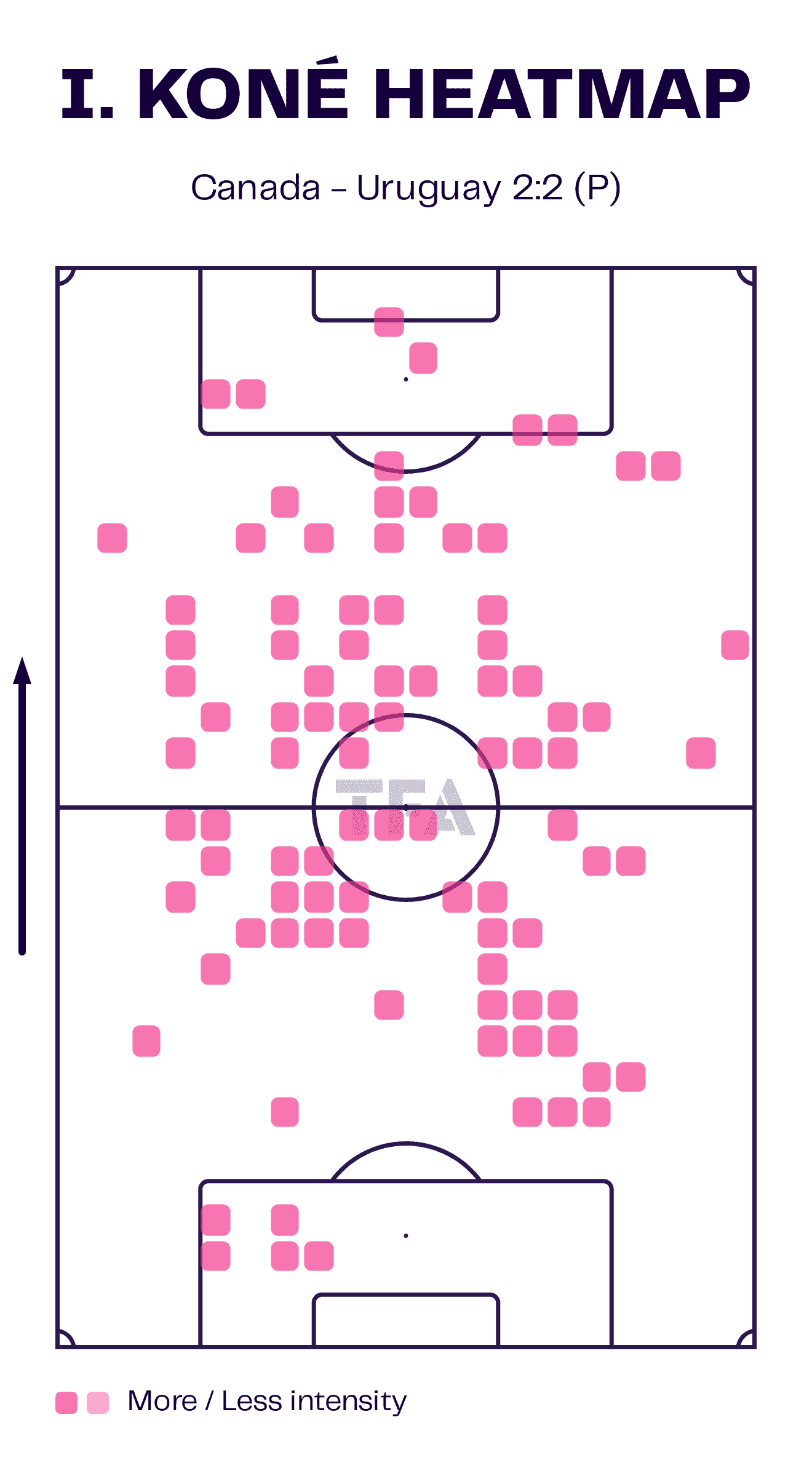
Jesse Marsch has predominantly used a 4-4-2 or 4-2-3-1 throughout this tournament.
Koné has operated as one of the midfielders in both formations.
As seen in Koné’s heatmap, he plays very much as a classic ‘8’, covering every blade of grass.
Koné has been partnered in midfield this tournament with either Porto’s Stephen Eustáquio or Jonathan Osorio.
Koné often seeks to break forward, meaning the defensive stability of both Eustáquio and Osorio creates the perfect blend.
Ismaël Koné Attacking phase
One area where Canada have struggled in this tournament is progressing the ball through the middle of the pitch.
Throughout the tournament, much of their success has come through working the ball down the flanks, with many of their wide players being standout performers in the tournament.
This game was significantly different.
Canada were able to penetrate the middle of midfield on countless occasions.
Much of this was down to Koné’s constant availability in midfield.
Koné was continually on the move getting into pockets of space where the ball could be progressed.
When passing the ball, he was quick to support his teammates, offering new angles to receive the ball.
Koné received more passes than anyone on the pitch (35), highlighting his effectiveness at being available for a pass.
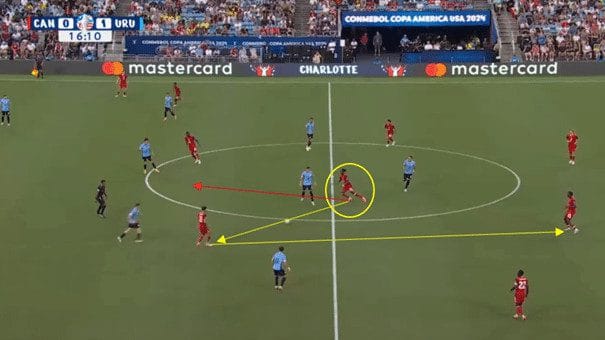
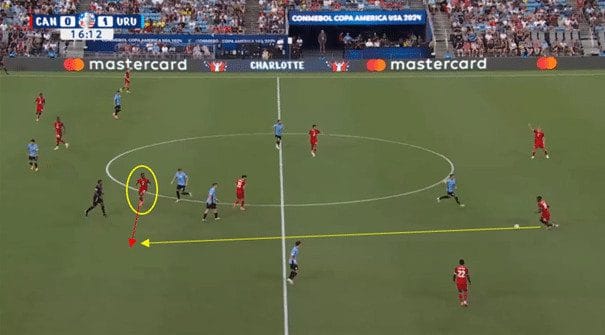
In this scenario, Koné passes the ball off to one of his teammates, who plays the ball back to one of Canada’s deepest players.
Koné moves into a new space and eventually receives a forward pass, allowing him to progress through the middle of the pitch.
Not only through his positioning and movement, yet his manipulation of the ball allows Koné to create space.
When receiving the ball in tight angles, Koné could outplay his opponents who were putting him under significant pressure.
Koné was successful in 73% of his attacking duels.
Once he had created space, he was quick to drive forward.
Koné was a real playmaker for Canada in this match.
His forward passing and progressive runs were at the heart of Canada’s positive attacking play.
Koné’s numbers display his ability in the game to progress the ball, making an outstanding nine progressive runs and 11 progressive passes.
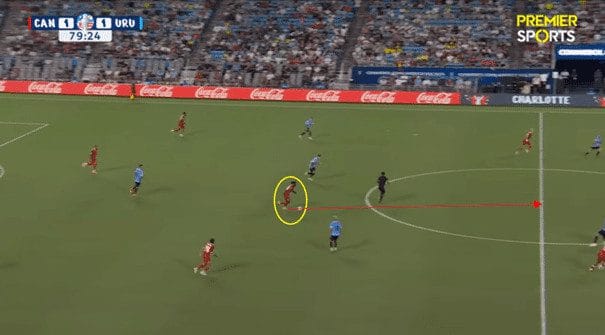
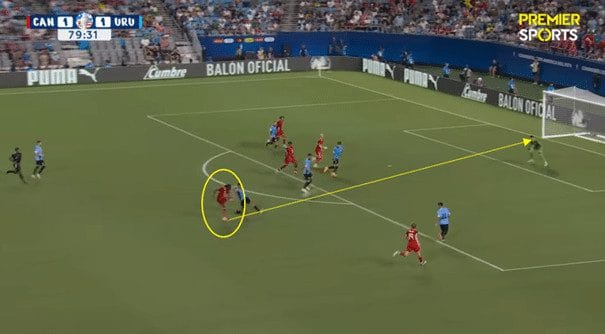
Here, Koné picks up the ball in midfield.
After scanning and seeing he’s free, he takes the ball on his back foot, allowing him to turn and drive forward.
After doing so, he drives at the heart of Uruguay’s defence, seeking to penetrate.
He beats an on-rushing defender on the edge of the opponent’s box, where he unleashes a rocket of a shot that is parried by Uruguay’s goalkeeper, but only into the path of Jonathan David, who tucks the ball away for Canada to take the lead.
Despite Koné’s willingness to play forward, at times, it went against.
On many occasions, he was unable to play the precise pass that was needed to unlock the Uruguayan defence.
Often, this was down to his decision-making rather than his execution.
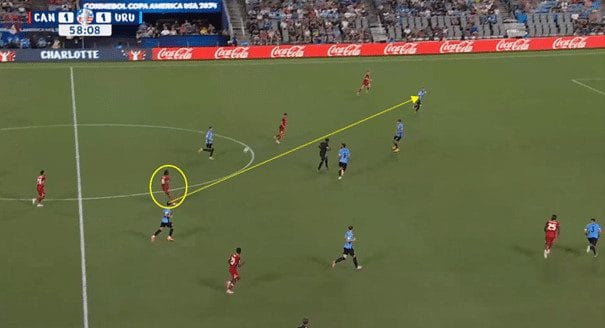
Koné, in this situation, attempts to play a ball over the top of Uruguay’s defence, trying to find his teammate, Jacob Shaffelburg.
This pass was extremely hard to complete, with the defending full-back having complete awareness of the forward run.
An option for Koné to play forward into the feet of one of the midfielders was also available, demonstrating this was the wrong decision.
Koné’s long pass completion rate was only 38%.
His forward pass completion rate was also lower than his average of 74.6%, reaching 61%.
Ismaël Koné Defensive Phase
Koné stuck to his task of closely marking the opposition’s midfield during Uruguay’s build-up play.
Jesse March’s side played with real aggression defensively, pressing high to force mistakes as Uruguay looked to play out from the back.
Koné remained compact, providing security with his teammates pressing.
Koné showed his effectiveness by making a couple of interceptions throughout the match in these situations.
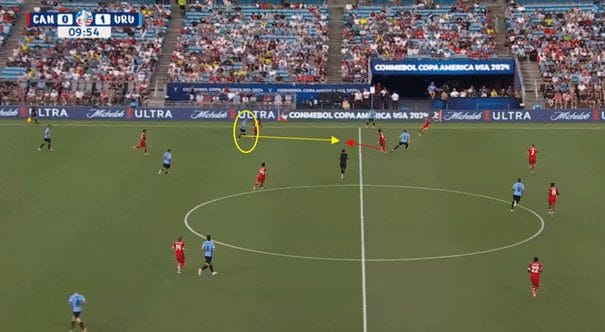
In this example, Uruguay have attempted to play around Canada’s press.
As they seek to play a penetrative pass into midfield, Koné steps across and makes a great interception.
This was one of the four interceptions Koné made throughout the match.
His defensive awareness was also seen deep in his own half.
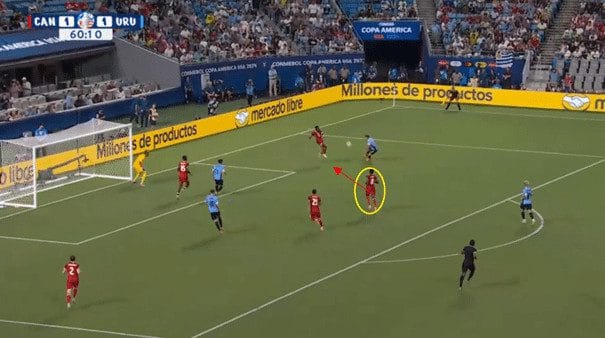
Here, Uruguay have bombed forward on the counter and have got in a promising position.
A cross has come in and is controlled by Luis Suarez.
Koné reads this and quickly gets across, taking the ball off Suarez and clearing the danger.
Koné was also quick to press when the ball came into his vicinity, fighting to win it back.
He won 75% of his defensive duels.
However, one area that Koné has been disappointing throughout the tournament is that he’s picked up needless yellow cards.
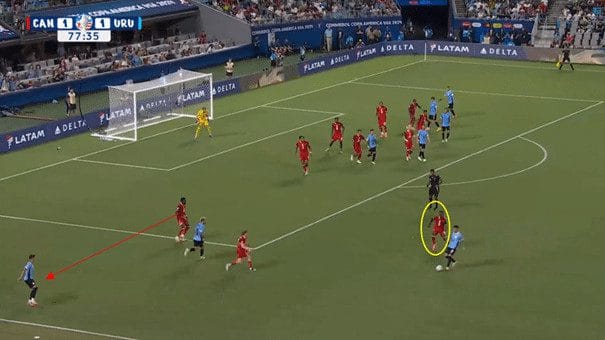
Here, Uruguay play the ball short from a corner.
Koné gets out quickly and prevents one of Uruguay’s attackers, who has come short during the corner, from crossing the ball.
Koné forces the player to pass the ball out wide, where his teammate Alphonso Davies is out quick to press the recipient.
However, Koné needlessly tackles his opponent from behind, giving Uruguay a free kick in a promising position.
Koné remains at the joint top for yellow cards in the Copa América.
Ismaël Koné Transitions
Koné was a real asset during the attacking transition for Canada, making the most of his standout qualities.
None more than his ability to carry the ball.
Koné’s progressive runs and dribbles from midfield are one of the features of his game that sets him apart.
Koné had a percentile rank of 82 for take-ons when compared to midfielders in the EFL Championship last season.
This was particularly seen during the transition between defence and attack, as Koné was often the first player to receive a pass after Canada regained possession.
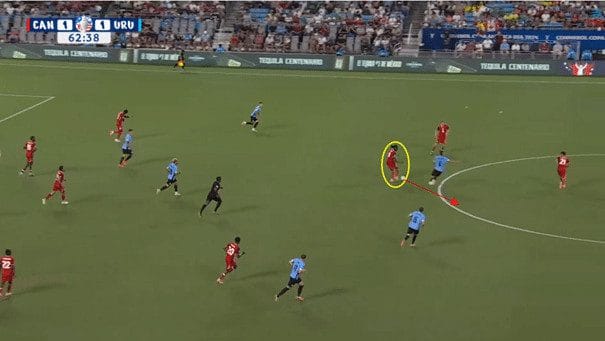
Here, Koné gets to a loose ball after Uruguay’s attack breaks down.
He then dribbles by his opponent easily and is subsequently fouled by the next defender he faces, who seeks to stop Koné from causing Uruguay problems on the counter.
Koné was the joint most fouled player in the match and completed 80% of his dribbles.
Koné also proved his worth during the counterpress.
Canada were quick to stop Uruguay counterattacking, winning the ball high up the pitch on several occasions.
Koné showed an ability in this game to steal the ball from the opposition in the transitional moments.
Half of his recoveries came in the opponent’s half of the pitch.
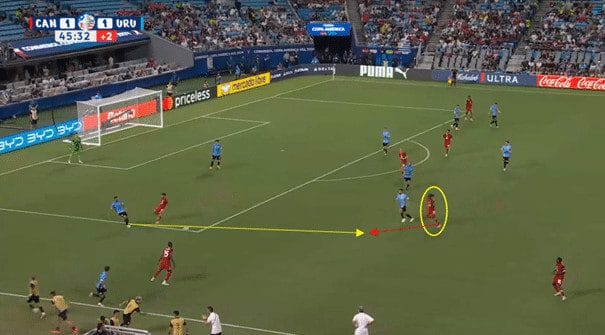
In this situation, Canada are pressing high up the pitch after they initially gave the ball away.
Koné reads the first pass that Uruguay attempt to play forward.
He wins the ball back and starts a dangerous attack for Canada.
Conclusion
Koné showed real quality throughout this performance.
In a tournament where Koné started the tournament as one of Canada’s first-choice midfielders; he’s shown great resilience to overcome the trials of tournament football, such as losing his place in the team and learning to compete at a higher level than he’s been used to.
He’s capped off the tournament with a strong performance as he prepares for a new challenge in France.
We predict that Koné will have a strong season with Marseille.
We don’t believe he will go straight into the starting lineup, yet imagine that the tenacity and resilience that he’s shown in this tournament and in his rise at Watford will help him establish himself in a new league.





Comments